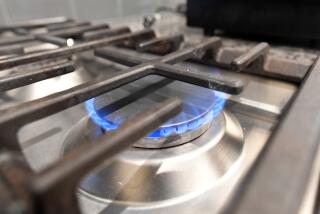Home Improvement : Ways to Get More Heat From an Old Fireplace
- Share via
QUESTION: I like to use my fireplace, but it cools my house more than heats it. I cannot afford a new efficient fireplace. What can I do to make my old fireplace produce some heat yet still watch the flames?
ANSWER: In the typical home, using a fireplace (wood or gas logs) can actually increase utility bills rather than cut them. To make the problem worse, a fireplace continues to waste energy year-round even when it is not being used.
There are several simple do-it-yourself fireplace kits and improvements to convert it from a heat waster to a heat producer. These improvements still allow you to watch the dancing flames and hear the crackling sounds.
For the most heat output, up to 40,000 BTU per hour, install a heat circulating grate, made of hollow tubing. Several effective designs are available for both natural wood or gas log sets.
Room air is circulated through the hot grate by a small blower. The blower is thermostatically controlled and continues to blow out warm air as long as the ashes and coals are still hot. The blower speed is adjustable.
The most efficient kits are designed to fit underneath glass doors. Cool room air is drawn in one side and hot air is blown out the other. It only raises the doors about an inch. These models also are designed with the blower behind the glass doors so it is not visible or noisy.
Installing good-quality glass doors is a must. These reduce the loss of heated room air when the fireplace is burning and when it isn’t being used. Most have screens inside so you can open the glass doors sometimes if you want to hear the crackling while the fire is burning.
Don’t just buy the cheapest glass door kit. Although they all look good, the best-quality, tight-sealing kits have smaller gaps between the door segments. They should be heavy and rigid to provide a good seal.
Select glass doors with adjustable slotted openings to control the air flow to the fire. Check the fit of the slotted slide. The back of the door frame should be stuffed with insulation to seal against the fireplace opening.
An antique style, decorative “fire back” also helps. This is a heavy metal plate placed in the back of the fireplace. When the fire back gets hot, it radiates more heat out directly into your room.
When your fireplace is not being used, insert an inexpensive reusable inflatable pillow seal in the flue opening. This blocks air leakage and provides insulation value. Place it up by the chimney damper and blow it up.
Write for Update Bulletin No. 714 listing manufacturers of heat circulating grates, high-quality efficient glass doors, inflatable pillow seals, fire backs and efficiency tips. Please include $2 and a business-size SASE and mail to James Dulley, Los Angeles Times, 6906 Royalgreen Drive, Cincinnati, Ohio 45244.
Outside Air Source Good Idea for New Furnaces
Q: I have been getting quotes on new high-efficiency furnaces. Is it important to have outside combustion air for the furnace?
A: It is always a good idea to supply outside combustion air to a gas or oil furnace, even if it isn’t a super-efficient design. Without outside combustion air, the air is drawn from inside your home. That can create chilly drafts and suck already-heated room air out the chimney.
With a condensing furnace, chlorides from bleach in the utility room air may cause corrosion in the furnace. The slight negative indoor pressure created by the lack of an outdoor combustion air supply can draw in radioactive radon gas in an area prone to it.
Letters and questions to Dulley, a Cincinnati-based engineering consultant, may be sent to James Dulley, Los Angeles Times, 6906 Royalgreen Dr . , Cincinnati, Ohio 45244.
More to Read
Inside the business of entertainment
The Wide Shot brings you news, analysis and insights on everything from streaming wars to production — and what it all means for the future.
You may occasionally receive promotional content from the Los Angeles Times.









